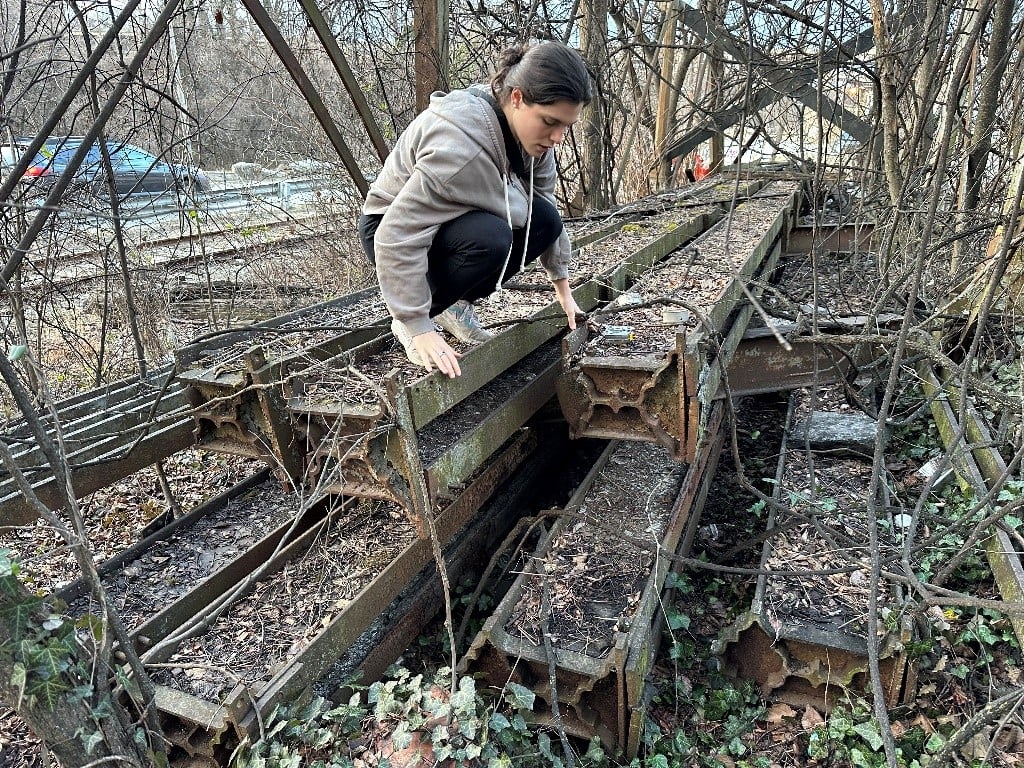Danielle McKenna
Senior undergraduate students in the Department of Civil and Systems Engineering are gearing up for the Whiting School of Engineering (WSE) Design Day on April 29, where they will present their capstone projects focused on a local cultural landmark: the Baltimore Streetcar Museum (BSM). While completely conceptual, the projects allow students to apply their engineering skills to real-world challenges.
Located just west of Hopkins’ Homewood campus, BSM houses a permanent collection of Baltimore’s street railway vehicles and is dedicated to preserving the city’s public transportation history. It’s also the subject of the students’ project to reimagine an existing structure and optimize surrounding land use to increase the number of visitors.
Three student teams—two consisting of civil engineering majors and one comprising systems engineering majors—are developing conceptual plans to enhance the museum by increasing display space and improving community accessibility. Though separate, the civil engineering teams have chosen to work collaboratively, focusing on the restoration and renovation of two structures: the Maryland and Pennsylvania Railroad Roundhouse and the Bollman Truss Bridge.
“To begin, both civil teams mapped out all the project elements together and then chose the components we were most interested in,” said Jenna Halpin, a civil engineering major and Bollman Truss Bridge team member. “Working this way gave us a broader perspective and more exposure to different parts of the design process.”
The first civil team, which includes Zach Martin, Ishmam Chowdhury, and Tyler Sugrim, is tasked with restoring the 1910 roundhouse. While BSM is leasing the structure from the City of Baltimore and plans to use the space to display its collection of streetcars, the city is currently using the roundhouse to store asphalt and salt—materials that have significantly weakened the structural system over time.
“This is the first time our class has taken on a full structural design and our instructor, John Matteo, has been an incredible mentor during the process, especially when it comes to communicating structural concepts and helping us visualize them through drawings,” said Martin.
The roundhouse team is designing with sustainability in mind.
“We hope to retain original features like high ceilings and large, second-story windows that historically let in enough sunlight to provide visibility and heat the interior, while incorporating new materials to replace the original elements, like lumber that’s no longer available,” said Tayo Ilunga-Reed. In lieu of timber, the team plans to use glue-laminated columns, a decision inspired by the team’s recent class trip to Hopkins’ new Student Center (currently under construction), which uses the same “glulam” technique.
Chowdhury’s team is also looking at car barn footings, “which offer more interior height without needing low-lying beams—something we learned about in our foundations course. The heightened beams would allow more space for the streetcar display and lend an open-air feeling to the space.”
Halpin and Ilunga-Reed—the second civil team—is focused on revitalizing the overall museum site and restoring a Bollman Truss bridge that was originally built in 1877 to span the Jones Falls. Their design includes options for relocating the bridge to serve as a passenger car entrance to the museum site or converting it into a pedestrian bridge to connect with an adjacent light rail stop.
Meanwhile, systems engineering seniors, Natalia Dougan and Maya Mann, are applying data analysis and optimization modeling to examine how the land surrounding the BSM can better serve the local community. Their model is aimed at improving accessibility and land use through enhanced transit options and thoughtful placement of amenities, like hospitals, parks, and schools.
“We’re looking at how to minimize the distance to amenities and how better transit can help bring more people to places in their own community, like the BSM,” said Mann. “We’re also designing our model so that it can be used for this particular neighborhood and so that it can be easily adaptable and scalable for other cities to implement.”
Using mobile phone data and focusing on 50 census blocks within a three-mile radius of the BSM, the team’s optimization model will be used to evaluate which amenities are lacking and where they could best be placed. Their model will also include transit optimization to calculate ideal routes and stop locations to maximize access through public transportation methods.
“Ultimately, our model would serve as a tool for city planners to make data-informed decisions that lead to better, more connected neighborhoods,” said Dougan.

